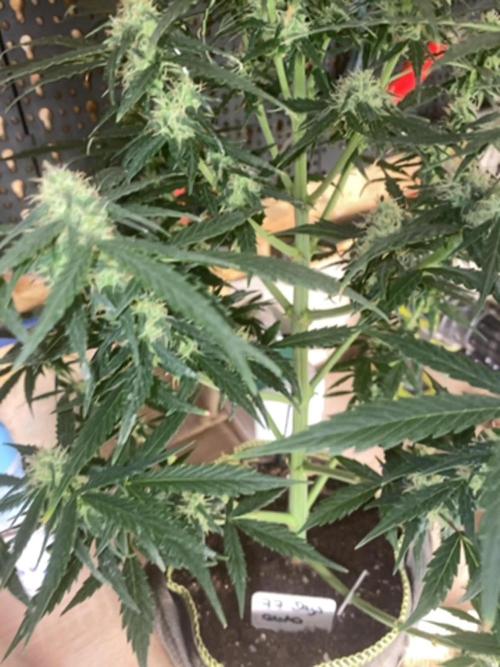The Grow Awards 2026 🏆 































Likes
Comments
Share


@S2993
Follow
Had a pooling problem in nft tanks so i think growth has been stunted a little?
Likes
7
Share


@Bluemels
Follow
Tag 39: Heute habe ich an alle Seitenarme Holzspieße befestigt. Befestigt habe ich diese mit kleinen Stücken Softdraht die Arme werden zusätzlich noch durch den Softdraht unten bzw. Vorerst in der Waagerechten gehalten(gezogen). Ich muss noch schauen wie ich die noch tiefer ziehe um eine optimale Lichtausbeute zu erreichen. Es ist also noch einiges an Geduld und Grübeln angesagt.
Tag 40: Die Cookie Gelato ist etwas zu trocken geworden, das ging so schnell ich hatte sie erst vor 2 Tagen gegossen davor alle 3. Die Blätter hängen schon, das LST hat sicher auch dazu beigetragen 😬 ich hoffe sie erholt sich.
Tag 41: Sie ist noch nicht aus dem gröbsten raus, so ein Mist. Das Wetter ist auch wieder so wechselhaft, ständig versuche ich den Schwankungen entgegen zu wirken, doch es gelingt mich nicht immer 😫
Likes
102
Share


@OrganicNature420
Follow
The mutants ended up being the best. An all rounder for sure. Smoke update coming soon with pics. The grow gods were with me through this one 💚
Likes
6
Share


@SleepHuntMadScience
Follow
Got through the wet and grey of the last week, should see some sun in the next few days to help finish the plant off.
Quite aesthetic with gdp colours and whit widow scent coming on strong.
Lookin forward to havest in the next week or two. Thanks to everyone who answered my grow question last week
Likes
20
Share


@gr3g4l
Follow
Esta semana empezó relativamente bién por lo que hace el tiempo y terminó con lluvias.
con 30 dias creo que se empezó a ver a observar algún pistilo por ahí por lo que ya comencé a regar con bloom
Os recuerdo que el agua de osmosis me sale a 0,08 Ec y 8 de ph , añadí un poco de cal-mag hasta 0,4 Ec, y con bloom hasta el 1,4 Ec . Para bajar PH ácido cítrico hasta dejarlo por debajo de 7ph. 6,5 áprox.
Likes
17
Share


@420DeepGrow
Follow
Gracias al equipo de Seedsman Marshydro XpertNutrients y Trolmaster sin ellos esto no sería posible.
💐🍁 Tangerine Snow F1 Fast:
Esta gran cepa es un cruce de cuatro vías 75% sativa de (Boost x Tangelo) con (Lavender x Power Plant). Este híbrido Fast F1 proviene de la genética Cali y cuenta con excelentes terpenos cítricos, alta producción de resina para extractos, altos niveles de THC, muy buenos rendimientos y excelente resistencia al moho. Tangerine Snow F1 Fast se puede cultivar tanto en interior como en exterior. Los tiempos de floración en interiores son de entre 8 y 10 semanas, mientras que el tiempo de cosecha en las latitudes del norte es en septiembre, mientras que en el hemisferio sur los productores cosecharán durante marzo. Las regiones climáticas recomendadas son cálidas, secas, húmedas y cálidas. Se trata de plantas altas, semiramificadas, que superan los 200cm y que presentan un alto vigor con muy buena uniformidad. Al igual que muchas otras variedades con fuerte dominancia sativa, Tangerine Snow F1 Fast ofrece una excelente resistencia al moho, así como a las plagas y enfermedades de las plantas. La combinación de terpenos cítricos y mucha resina la convierten en una cepa de muy buen extracto, cuyo método de "lavado" produce muy buenos rendimientos de hachís. El perfil de terpenos cítricos recuerda a las mandarinas y mandarinas y también tiene notas dulces. La producción de THC ha sido verificada en laboratorio en un fuerte 24%, mientras que el CBD es bajo. El efecto es edificante y energizante, perfecto para usar durante el día y las primeras horas de la noche.
🌻🚀 Consigue aqui tus semillas:
💡TS-3000 + TS-1000: se usaran dos de las lámparas de la serie TS de Marshydro, para cubrir todas las necesidades de las plantas durante el ciclo de cultivo, uso las dos lámparas en floracion para llegar a toda la carpa de 1.50 x 1.50 x 1.80.
https://marshydro.eu/products/mars-hydro-ts-3000-led-grow-light/
🏠 : Marshydro 1.50 x 1.50 x 1.80, carpa 100% estanca con ventanas laterales para llegar a todos los lugares durante el grow
https://marshydro.eu/products/diy-150x150x200cm-grow-tent-kit
🌬️💨 Marshydro 6inch + filtro carbon para evitar olores indeseables.
https://marshydro.eu/products/ifresh-smart-6inch-filter-kits/
💻 Trolmaster Tent-X TCS-1 como controlador de luz, optimiza tu cultivo con la última tecnología del mercado, desde donde puedes controlar todos los parametros.
https://www.trolmaster.com/Products/Details/TCS-1
🍣🍦🌴 Xpert Nutrients es una empresa especializada en la producción y comercialización de fertilizantes líquidos y tierras, que garantizan excelentes cosechas y un crecimiento activo para sus plantas durante todas las fases de cultivo.
Consigue aqui tus Nutrientes:
https://xpertnutrients.com/es/shop/
📆 Semana 4:
Continuamos la etapa de vegetación, ella se desarrolla muy bien 😎, comienza el buen tiempo, temperaturas agradables para todos.
Esta semana se aplica una solución de trichodermas para una mejor adaptación aunque realmente va genial.
Se mantiene 1/3 de nutrientes Master Root y Master Grow
Likes
15
Share


@XperencdGmanXG
Follow
Amended for the upcoming flop to flower, These girls like to stretch a lot so I've tried to leave a lot of room. Also cleaned up the inside for better airflow and light penetration. Will be amending them will bloom minerals this week as they transition to flower.
Likes
1
Share


@Osavv_OTGUK
Follow
I set up a scrog net at this moment of time I wasn’t sure how to set it up until I watched a couple of videos. One of the bag seed girls started showing which was amazing. I was still waiting for the other bag seed to show. The female gorilla cookies started to show which was also amazing
Likes
20
Share


@Gardengobblin
Follow
Mes crayon à ph était defect j'ai donc eu quelque petit problème mais j'ai remédier en achetant un nouvelle appareille .
Ph réajuster donc tout est revenue à la normale .
Les tête gonflé encore.
Le smoothie va commander son rinçage au prochaine arrosage pour 2 semaine complète.
Les 3 autre son capables de prendre au moins une as 2 autre semaine avant le rinçage. Merci de me suivre 💪🏼
Likes
3
Share


@danielsegovia
Follow
06.06.20Hace varios dias transplanté a todas a una maceta de 15 litros pero con sólo 9 litros de sustrato.
Hice una aplicación de estimulante de raíz para atenuar el estrés por transplante.
10.06.20 Regué con toda la línea Top crop, muestran un buen crecimiento
Likes
14
Share


@Dieselnutz
Follow
57 days of flower. Lookin like they are gonna go at least 10-11 weeks.. starting to think the burning on these girls were actually a P deficiency, started adding half a dose of bud xl with the jacks and they seem to be responding well. Been feeding around 750ppm this week run off was around 950 think I will continue at 750 but drop it to 500 next week and ride her out
Likes
11
Share


@Nutrient_gro
Follow
Just been adding water when dry. Adding some pure worm castings top dresses. Will be adding Gaia green all purpose in a week or 2 when needed.
Likes
4
Share


@AustinRon
Follow
LJ 2Q24 Flower Week 6
Start of Week:
- [Sun Aug 4, 2024, LJ 2Q24 36:F:6:1]
- Plant Heights: [ 25, in]
End of Week:
- [Sat Aug 10, 2024 LJ 2Q24 42:F:6:7]
- Plant Heights: [ 26, in]
EC: 2.4. # Until Week 10
__
Sun Aug 4, 2024
LJ 2Q24 36:F:6:1
Add 7.5 ml of Dr. Zymes to 1 PT of Last Two Plants Feed (Ran out last night)
THIS CHART FOR WEEKS 7 -
DEHU Water, Reducing Lush Green (N), Eliminating Root Anchor
+ PSP, 1 Drop Beauvaria Bassiana Soluble
__
Mon Aug 5, 2024
LJ 2Q24 37:F:6:2
RLA Week 6 +BioAg TM-7
Nik wonders if it might actually be a molybdenum deficiency w/ Lemon Jeffery.
__
Tue Aug 6, 2024
LJ 2Q24 38:F:6:3



Environmental:
- LightIntensityAvg: [ 836, µMol/m2/s]
- TempAvg: [ 78.4, °F]
- RHAvg: [ 65.7 , %]
- VPDAvg: [ 0.90 , kPa]
- EC: [ 2.4, mS]
Note:
- Nik @TheRootedLeaf mentioned Molybendum as an ESSENTIAL µNutrient participating in Nitrogen Reduction.
- The BioAg TM-7 contains Mb, Apply @ 1 tsp/gal

__
Wed Aug 7, 2024
LJ 2Q24 39:F:6:4
__
Thu Aug 8, 2024
LJ 2Q24 40:F:6:5
Note:
- We really need at least 2 Fertigations/day, @2000 & @0130
- We’ll water to saturation each event (10% Pot Volume, 440 ml/plant/event)
- We need 440 * 2 * 7: 6.16 Liters,Need 1.62 Liters, Will mix 1.75
- Need to increase daily total from 1.5 to 2 Gallons
- 1.1 L/Plant/Day
- 440 ml/plant/event * 2
Per Event
- Estimate Minimal Runoff
- Pot Size 4.4 Liters
- Saturation: 440 ml
- 0% Runoff
1.75 Gal, 5700 ml, 814 ml
- [x] Light Defoliation (as needed/lowers)
Feed Chart for 1.75 Gallons
Apply 440 ml/plant @ 2000 & @ 0130
- [x] Mixed! 2024-08-08T16:03:01-0500


__
Fri Aug 9, 2024
LJ 2Q24 41:F:6:6
- [ ] Collect Dehu Water
- [ ] Water 440/plant @ 2000
- [ ] Water 440/plant @ 0130
880 ml/plant/day * 7 : 6160 ml, 1.62 Gal
__
Sat Aug 10, 2024
LJ 2Q24 42:F:6:7
Likes
29
Share


@BioGrowKing
Follow
Die Woche war naja so okay die Blätter hängen nicht mehr allerdings sind sie immer noch angefressen ich weiß nicht was es ist ich habe sie jetzt Vor paar Tagen getoppt. Und habe sie auch in die Blüte geschickt allerdings weiß ich nicht ob sie durch ein Experiment habe auch hier Nematoden hinzugefügt weil wir irgendwelche Würmer im Boden entdeckt haben beziehungsweise Larven von den Fliegen die überall rum fliegen. Jetzt abwarten wenigstens stehen die Blätter wieder schön ganze wächst weiter das war wohl viel Stress mit in die Blüte schicken und Toppen in einer Woche aber abwarten. Ich hoffe dass die Blätter so sind wegen den Fliegen und nicht wegen über Besserung allerdings habe ich sie auch austrocknen lassen und jetzt noch mal neu gegossen mit den Nematoden bis nächste Woche
Likes
13
Share


@HIAZ_urbanbudfarmer
Follow
Time for flower. Cleaned my flowering tent & equipment & transferred the girls from veg tent.
Developed really nice structure on these plants.
Use the promo code GROWEED for a 15% discount on any Fast Buds purchase!
Likes
26
Share


@Highgrade_Harvests
Follow
One more week of veg then flipping the lights to 12/12. I've been so busy with work and the outside garden that I haven't had much time to maintain these plants but they are doing very well considering. I've topped all plants and pulled branches down to spread canopy. A lot of defoliation has been needed along the way and I've done some lst and hst also. Once I flip the lights they should fill the tent up nicely. Being conservative with the nutrients. I will bump up a little bit once they are in flower.
























